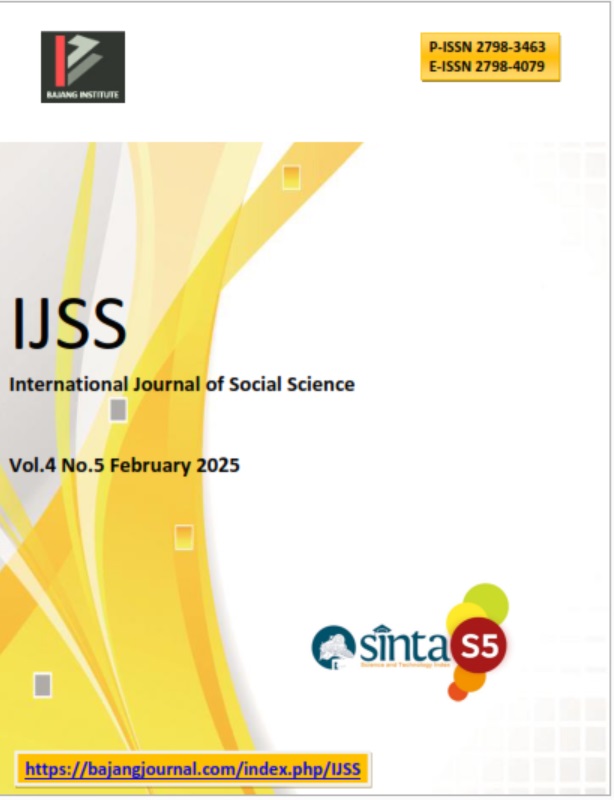2D ANIMATE CREATION ‘PRODIGAL SON’ GESTALT MOVS
DOI:
https://doi.org/10.53625/ijss.v4i5.9928Keywords:
Gestalt MoVS, Bible Story Animation, Prodigal SonAbstract
The creation of the 'Prodigal Son' animation stems from the author's realization of the need for fresh and engaging church teaching media for youth aged 12-17. Current media often lack appeal, as they focus only on storylines without offering deeper engagement. This gap highlights the urgency to develop new media that effectively delivers story essence using the Gestalt MoVS(Movement on Voice and Spirit) visual style. The study addresses how to create animation that fills this gap, applies Gestalt MoVS concepts, and visualizes the 'Prodigal Son' story through this approach. Utilizing a descriptive qualitative method and practice-based research, the process includes literature studies on Gestalt MoVS theory, theological philosophy, hermeneutics, semiotics, VCD (Visual Communication Design) principles, and expert interviews with theologians, animators, media experts, and adolescent psychologists. Media trials with targeted audiences also contribute to the visual analysis. The result is an aesthetically pleasing animation that conveys the story's three main essences—repentance, forgiveness, and gratitude—in a paradoxical configuration, addressing both repentant audiences and those who judge others. The animation offers an innovative solution to engage teens and simplify Bible story delivery, emphasizing an interdisciplinary approach to inspire spiritual understanding and real-life application.
References
Aquinas, T. (1981). Summa Theologica. New York, NY: Christian Classics.
Barron, R. (2015). The Priority of Christ: Toward a Postliberal Catholicism. Grand Rapids, MI: Baker Academic.
Barthes, R. (1977). Image, Music, Text. London, England: Fontana Press.
Chandler, D. (2007). Semiotics: The Basics (2nd ed.). London, England: Routledge.
Darmawan, A. J., Sedana, I. N., & Marianto, M. D. (2023). Unveiling the Aesthetic Connection: Balinese Wayang Characters and the 'Prodigal Son' Bible Story. Dewa Ruci: Jurnal Pengkajian dan Penciptaan Seni, 18(1), 56-68.
Eco, U. (1979). A Theory of Semiotics. Bloomington, IN: Indiana University Press.
Green, J. B. (1997). The Gospel of Luke. Grand Rapids, MI: Eerdmans.
Keller, T. (2008). The Prodigal God: Recovering the Heart of the Christian Faith. New York, NY: Dutton.
Kress, G., & van Leeuwen, T. (2006). Reading Images: The Grammar of Visual Design (2nd ed.). London, England: Routledge.
McCloud, S. (1994). Understanding Comics: The Invisible Art. New York, NY: HarperCollins Publishers.
Merriam, S. B. (2009). Qualitative Research: A Guide to Design and Implementation. San Francisco, CA: Jossey-Bass.
Piaget, J. (1972). The Psychology of the Child. New York, NY: Basic Books.
Schleiermacher, F. (1998). Hermeneutics and Criticism and Other Writings. Cambridge, England: Cambridge University Press.
Stein, R. H. (1994). The Method and Message of Jesus’ Teachings. Louisville, KY: Westminster John Knox Press.
Thomas, F., & Johnston, O. (1981). The Illusion of Life: Disney Animation. New York, NY: Walt Disney Productions.
Wertheimer, M. (1938). Laws of Organization in Perceptual Forms. In Ellis, W. (Ed.), A Source Book of Gestalt Psychology. London, England: Routledge & Kegan Paul.
Williams, R. (2001). The Animator’s Survival Kit. London, England: Faber and Faber.
Downloads
Published
How to Cite
Issue
Section
License
Copyright (c) 2025 Andreas James Darmawan, I Made Gede Arimbawa, I Ketut Muka, I Nyoman Suardina

This work is licensed under a Creative Commons Attribution 4.0 International License.

















